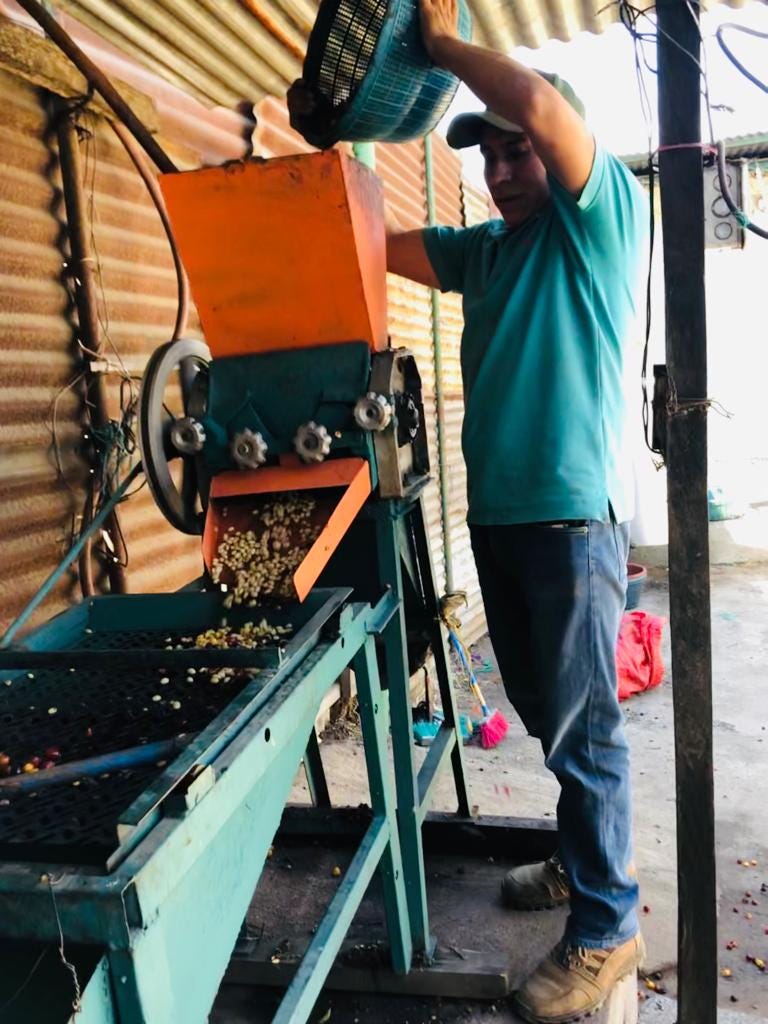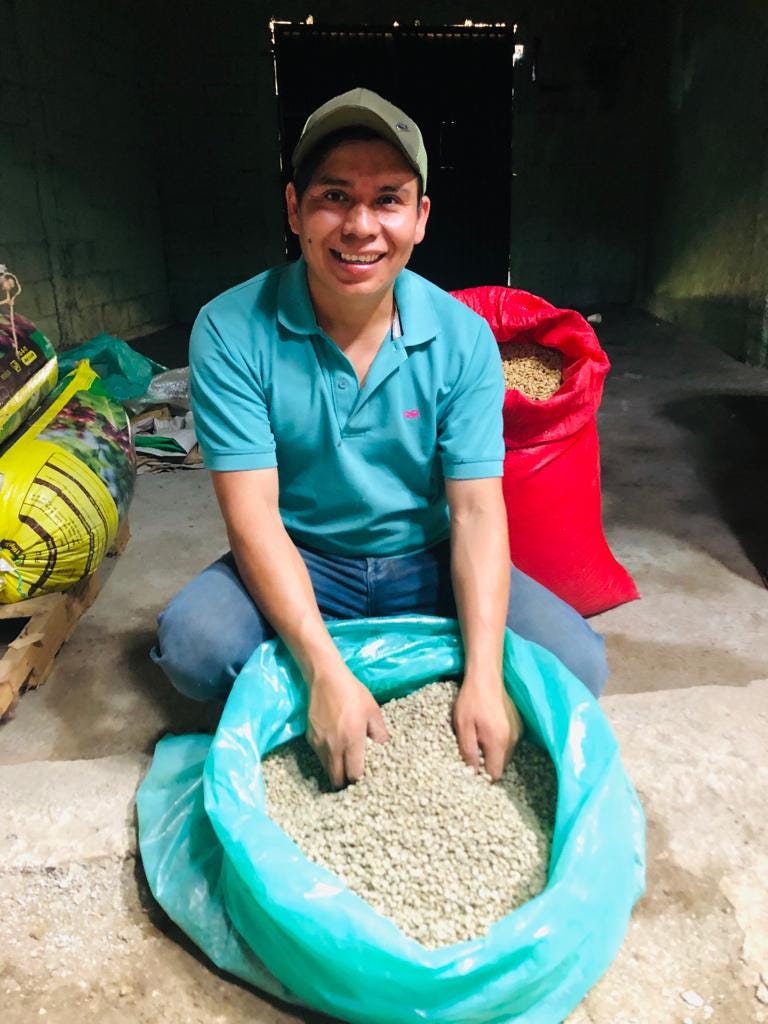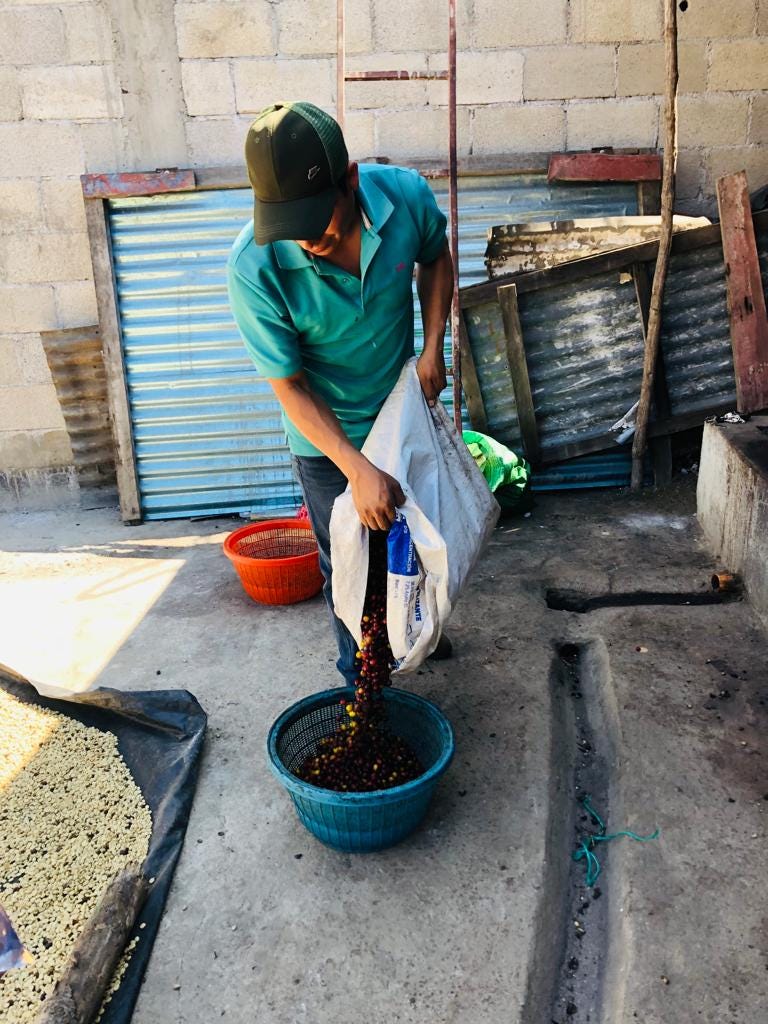What does world's most sustainable coffee taste like?
The Coffee Postharvest Process
In English we call them coffee beans, but they are actually the seeds of the coffee plant, and they develop inside the plant’s fruit. With coffee, this fruit is small and cherry-like, often deep red when ripe, but there are also varietals that produce yellow, pink, and orange cherries.
The process of converting a fleshy, juicy coffee cherry into a dry, exportable product involves many steps, and each of these steps is critical if one wants to produce a high-quality coffee.
First, the coffee cherry must be picked at optimal ripeness. If the cherry is picked too early, the tannin content will be high in the seed and produce an undesirable astringency. If picked too late, the sugars in the fruit will begin to ferment, creating funky, vinegary flavors later on. A perfectly ripe cherry, however, will be chock full of sugars that will result in a sweeter cup of coffee.
After picking, there are a few different methods for drying the coffee down to a stable moisture level so that it can be milled and exported. In Latin America, the predominant method is known as the “washed” method. In this method, the coffee is depulped and piled up in a tank to ferment. Between the outer flesh of the coffee cherry and the inner seed is a sticky, sugary mucilage layer. In Spanish, this is known as miel, or honey, which gives a good idea of what this sticky stuff is like.
Once the coffee is depulped, the wild yeasts present on the cherry skins begin to consume this mucilage and in so doing, weaken the mucilage’s bond to the coffee seed. Then, the mucilage can be washed away with water, hence, the name “washed process.”
It’s interesting to note that the washed method was developed as a solution to processing coffee in the Central American climate, which is more humid during harvest time. By washing off the mucilage, the coffee is less likely to spoil while drying. The fermentation also results in a clean and bright flavor profile, where as natural processes— drying the seed directly in the fruit— tend to produce sweeter, fruitier profiles.
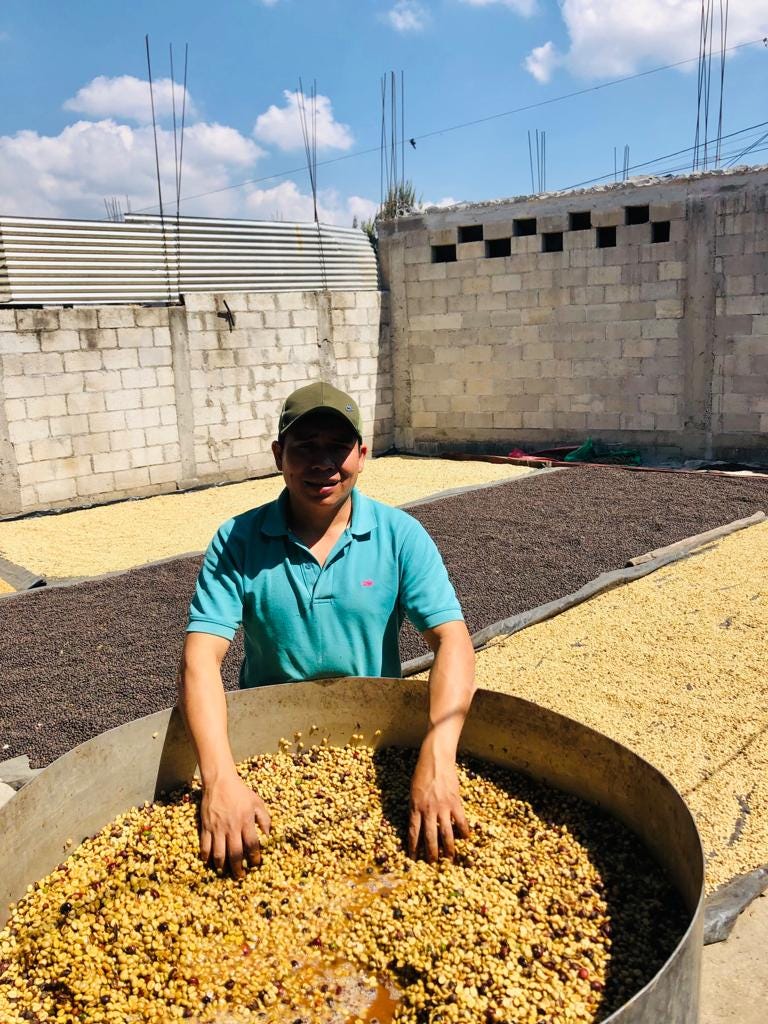
After being washed, the coffee is sent to drying beds or a patio to dry, and this can take anywhere from one to three weeks. At this point, the coffee seeds are still protected inside a husk which in Spanish is called pergamino, which means parchment. In pergamino, the coffee is left to rest in sacks for a period of about one month. During this time, the remaining moisture content in the coffee beans equalizes throughout the coffee sacks and the flavors further develop.
After this rest, the coffee is milled in preparation for export. First, the parchment layer is removed with a dehuller, exposing the green coffee inside. Then, the coffee will be sorted for screen size by vibrating it across perforated screens with a particular gauge hole, screening out beans that are too small or too large. For roasters, a more uniform bean size means the beans will react more uniformly in the roaster, resulting in a higher quality roast.
Finally, there is usually one last step of removing any defects that were not caught earlier in the process. In large farm operations, this is commonly done by women sitting at a conveyor belt which rolls the coffee past them for hours at a time. For family farms, it’s often done at a table, one basket at a time.
After this last sorting stage, the coffee is bagged and prepared for export.
A strong foundation allows us to innovate in new directions
We knew from the start of Biota Coffee that we wanted to work with outstanding farmers like our first partner, Manuel Gutierrez, because he has already mastered this postharvest process and is able to consistently deliver world-class coffee.
It’s worth reflecting that a smallholder farmer like Manuel is able to pull off such a feat in an underdeveloped country like Guatemala. The quality of his coffee is a testament to the support he has in his cooperative and our logistical partner De La Gente, but most of all, to Manuel’s own attention to detail and passion for doing his work well.
For many coffee farmers around the world, some fine-tuning in the above-described depulping, fermenting, washing, and drying of the coffee can quickly boost the quality of their coffee into the territory known as “specialty coffee,” but only up to a certain point.
For farmers like Manuel, who have already reached this quality ceiling, the only way to further improve their quality is by improving the quality of the plants’ cherries themselves. This is where sustainable agricultural practices stand to contribute, and as I see it, there are three areas where the development of a regenerative environment can positively impact the flavor profile of Manuel’s coffee.
Benefit 1: Soil health — Plant health
The first benefit that sustainable agroecology yields is in the soil. As I described in an earlier post, plants naturally thrive in healthy soils; their root systems interact with the vast diversity of bacteria, fungi, protozoa, and other soil micro-cosmos residents to cycle and uptake nutrients.
Logically, a plant that is able to feed itself optimally will achieve a higher overall health than a plant subject to onslaughts of toxic chemical fertilizers. Plants in rich, mycorrhizal-dominated soils will have more access to water and other nutrients and thus be less stressed by heat, drought, or other factors.
And because plants are primarily geared toward reproduction, all of their energy goes toward producing seeds encased in fruit. Thus, the more nutrition available to the plant, and the less stress the plant has to overcome throughout its lifecycle, the more carbohydrates, starches, sugars, proteins, etc. it will be able to deliver to its seeds, all of which means more flavorful coffee.
Benefit 2: Better conditions for fruit development
Cooler growing conditions allow more time for the coffee plant to pump nutrition from the soil up into the coffee cherries. This is why high altitude coffees have such high quality potential— high on mountains, where the days are cool and the nights are very cool, coffee cherries have even longer to develop than those grown at lower elevations.
Our partner, Manuel, is growing coffee at around 1900 meters above sea level, which is quite high, even for coffee. But by implementing a shade canopy, he will be able to further regulate sun exposure during the daytime as well as trap moisture at ground level around the plants, creating a misty microclimate that is ideal for the slow ripening of fruits.
Besides just having more overall nutrition, coffee cherries that develop more slowly stand to have more complex organic acid profiles. This is because the organic acids present in coffee cherries develop successively. Citric acid (think lemons, oranges) develops first, followed by malic acid (like green apples and wines). So, not only would the flavor profile be intensified in a longer-developing cherry, it could actually change significantly as different combinations of sugars and acids form in the cherry, which then react chemically during the roasting process.
Benefit 4: More diverse wild yeast population leads to different fermentation outcomes
As I described above, the fermentation step is a critical point in the development of the flavor profile of washed coffees. This fermentation step almost universally relies on the wild yeasts present on the fruit skins at the time of harvest. Yet the toxic chemicals which are commonly sprayed on coffee plants to prevent pests also kill off beneficial microorganisms, including wild yeasts.
Coffee fermentation is a complex series of interactions between yeasts and other microorganisms, mainly bacteria, so a change in the starting population could have a “chain reaction” type effect that could significantly alter the end flavor profile of the coffee.
The Secret Ingredient
We’re very excited to document the changes that implementing sustainable, regenerative farming techniques with Manuel will yield on the quality of his coffee.
Because we have such a tight, direct relationship with him, we trust that he will maintain his high personal standards for the harvesting, fermentation, drying, and milling of his coffee. This means that any quality changes will be due to the regenerative farming practices we have already begun to implement together, and which we will continue to strengthen over time.
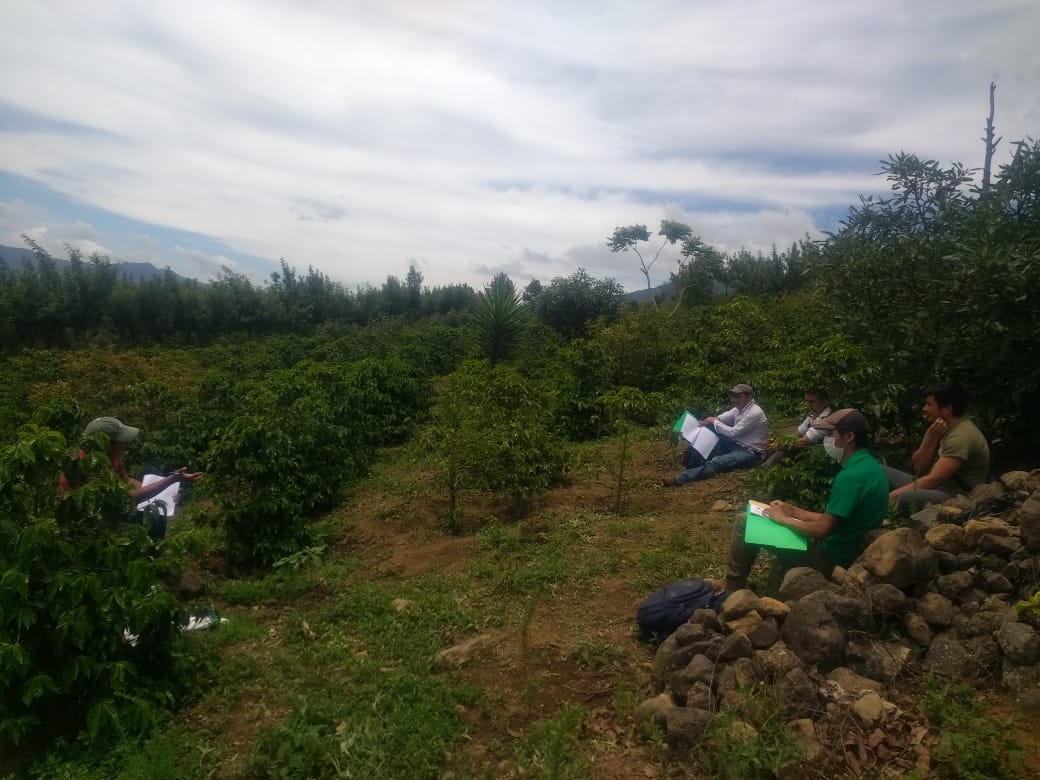
Yet we cannot separate ecology or quality entirely from the context from which they emerge. In the realm of smallholder coffee farming, ecological sustainability, economic sustainability, and quality are all tightly interwoven. An external factor that impacts one of these areas will also affect the others.
At Biota Coffee, our regenerative farming mission is designed to engage all of these dimensions. The ecological component of our project is based on strong, personal relationships, an economic model that works for all, and a shared love of the work that we do, a passion for working with nature, a passion for working with coffee.
I was speaking with Manuel on the phone recently and he was telling me how excited he was to see his vermicomposting operation grow. “Me motiva mucho,” he told me— “It’s very motivating.”
This is the X-factor that is already present in Biota Coffee, and that will continue to increase as we progress toward our goals: the joy of working sustainably, the love of what we do.






